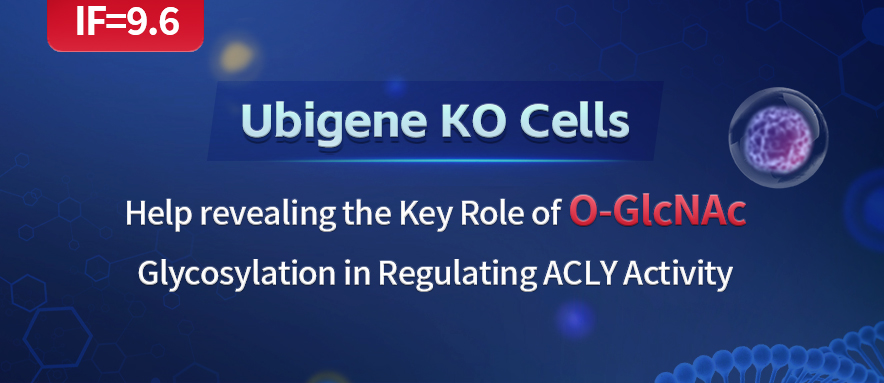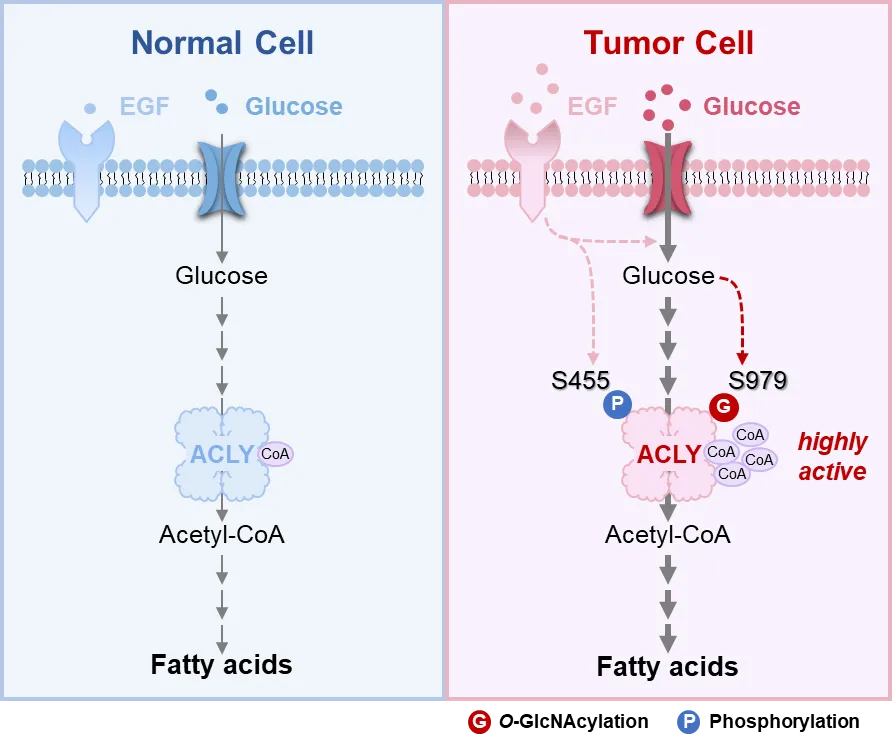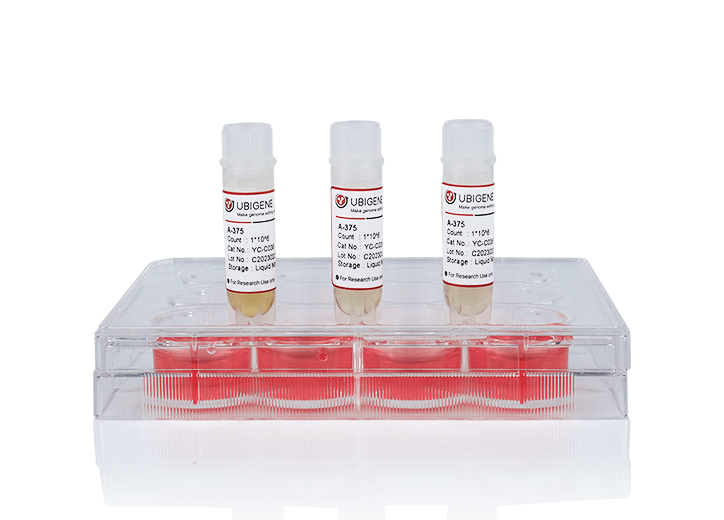Location:Home > Application > Ubigene KO Cells help Revealing the Key Role of O-GlcNAc Glycosylation in Regulating ACLY
Ubigene KO Cells help Revealing the Key Role of O-GlcNAc Glycosylation in Regulating ACLY Activity

Rapid proliferation and continuous division of tumor cells rely on membrane lipid duplication, making vigorous lipid synthesis a key metabolic feature of tumor cells [1-3]. ATP-citrate lyase (ACLY), a crucial enzyme in the fatty acid synthesis pathway, catalyzes the citrate and CoA to form acetyl-CoA, a two-carbon unit required for de novo fatty acid synthesis. The expression and activity of ACLY are regulated by phosphorylation, acetylation, and ubiquitination [4-7]. Recent studies also discovered that ACLY can undergo O-GlcNAc glycosylation. O-GlcNAc glycosylation is widely considered a "sensor" that can sense nutritional fluctuations [8-12], but the biological significance and how it perceives nutrient abundance in ACLY remain unclear.
Recently, a study published by the research team of Min Wei and Yunpeng Feng from the Key Laboratory of Molecular Epigenetics at Northeast Normal University in PNAS (IF: 9.6) titled "O-GlcNAcylation of ATP-citrate lyase couples glucose supply to lipogenesis for rapid tumor cell proliferation" reported the crucial role of O-GlcNAc glycosylation in the regulation of ACLY activity. Using Ubigene's ACLY knockout A549 cell line and the complemented ACLY WT and S979A cell lines, the study explains the effects of removing the S979 O-GlcNAc glycosylation on tumor cell proliferation.
The study elucidates how ACLY senses elevated glucose levels through O-GlcNAc glycosylation, thereby enhancing lipid synthesis and promoting rapid tumor cell proliferation. Proteomics analysis identified S979 as the major O-GlcNAc glycosylation site of ACLY. This modification significantly enhances the binding of substrate CoA to ACLY, increasing its enzymatic activity and promoting fatty acid and lipid generation. Metabolic flux analysis using [U-13C] glucose demonstrated that the O-GlcNAc glycosylation of ACLY S979 can dynamically regulate the carbon units derived from glucose entering the de novo fatty acid synthesis pathway, in response to glucose concentration changes. Thus, the O-GlcNAc modification at S979 links glucose supply to lipid synthesis. The study also found that the level of ACLY O-GlcNAc glycosylation was significantly increased in tumor cells and tissues. In vivo xenograft experiments showed that disrupting the O-GlcNAc glycosylation of ACLY S979 significantly inhibited the promoting effects of glucose and EGF on tumor growth.

Interestingly, it is known that the growth factor EGF enhances ACLY activity by promoting the phosphorylation of S455, which increases the binding of citrate to ACLY [6,13-17]. The study also revealed that the O-GlcNAc glycosylation of ACLY S979 enhances the binding of another substrate, CoA, to ACLY. The two modifications at S455 and S979 work independently but both are necessary for product formation. EGF signals promote glucose uptake, which upregulates ACLY O-GlcNAc glycosylation. Therefore, these nutrient-dependent glycosylation and phosphorylation modifications regulate ACLY activity directly or indirectly through EGF signaling.
This study sheds light on how cells perceive the abundance of sugars to guide fatty acid synthesis and promote cell proliferation. From an evolutionary perspective, it provides new insights into the regulatory mechanisms of cell proliferation in multicellular organisms: while proliferation in multicellular organisms is controlled by mitogen signaling, the ancient nutrient-sensing mechanisms, which control proliferation in single-cell organisms, remain conserved, and the process of mitogen signaling promoting cell proliferation still needs to be verified by specific nutrient “checkpoints”.
References:
1. Röhrig F, Schulze A. The multifaceted roles of fatty acid synthesis in cancer. Nat Rev Cancer. 2016. 16(11): 732-749.
2. Snaebjornsson MT, Janaki-Raman S, Schulze A. Greasing the Wheels of the Cancer Machine: The Role of Lipid Metabolism in Cancer. Cell Metab. 2020. 31(1): 62-76.
3. Storck EM, Özbalci C, Eggert US. Lipid Cell Biology: A Focus on Lipids in Cell Division. Annu Rev Biochem. 2018. 87: 839-869.
4. Lin R, Tao R, Gao X, et al. Acetylation stabilizes ATP-citrate lyase to promote lipid biosynthesis and tumor growth. Mol Cell. 2013. 51(4): 506-518.
5. Zhang C, Liu J, Huang G, et al. Cullin3-KLHL25 ubiquitin ligase targets ACLY for degradation to inhibit lipid synthesis and tumor progression. Genes Dev. 2016. 30(17): 1956-70.
6. Lee, JV, et al. Akt-dependent metabolic reprogramming regulates tumor cell histone acetylation. Cell Metab 2014;20:306-319.
7. Icard P, Wu Z, Fournel L, Coquerel A, Lincet H, Alifano M. ATP citrate lyase: A central metabolic enzyme in cancer. Cancer Lett. 2020. 471: 125-134.
8. Bauer DE, Hatzivassiliou G, Zhao F, Andreadis C, Thompson CB. ATP citrate lyase is an important component of cell growth and transformation. Oncogene. 2005. 24(41): 6314-22.
9. Qin W, Lv P, Fan X, et al. Quantitative time-resolved chemoproteomics reveals that stable O-GlcNAc regulates box C/D snoRNP biogenesis. Proc Natl Acad Sci U S A. 2017. 114(33): E6749-E6758.
10. Wang Y, Liu J, Jin X, et al. O-GlcNAcylation destabilizes the active tetrameric PKM2 to promote the Warburg effect. Proc Natl Acad Sci U S A. 2017. 114(52): 13732-13737.
11. Rao X, Duan X, Mao W, et al. O-GlcNAcylation of G6PD promotes the pentose phosphate pathway and tumor growth. Nat Commun. 2015. 6: 8468.
12. Yi W, Clark PM, Mason DE, et al. Phosphofructokinase 1 glycosylation regulates cell growth and metabolism. Science. 2012. 337(6097): 975-80.
13. Guo, D, et al. EGFR signaling through an Akt-SREBP-1-dependent, rapamycin-resistant pathway sensitizes glioblastomas to antilipogenic therapy. Sci Signal 2009;2:ra82.
14. Tomas, A, Futter, CE, Eden, ER. EGF receptor trafficking: consequences for signaling and cancer. Trends Cell Biol 2014;24:26-34.
15. Manning, BD, Toker, A. AKT/PKB Signaling: Navigating the Network. Cell 2017;169:381-405.
16. Potapova, IA, El-Maghrabi, MR, Doronin, SV, Benjamin, WB. Phosphorylation of recombinant human ATP:citrate lyase by cAMP-dependent protein kinase abolishes homotropic allosteric regulation of the enzyme by citrate and increases the enzyme activity. Allosteric activation of ATP:citrate lyase by phosphorylated sugars. Biochemistry 2000;39:1169-1179.
17. Kanao, T, Fukui, T, Atomi, H, Imanaka, T. Kinetic and biochemical analyses on the reaction mechanism of a bacterial ATP-citrate lyase. Eur J Biochem 2002;269:3409-3416.


Ubigene KO Cells help Revealing the Key Role of O-GlcNAc Glycosylation in Regulating ACLY Activity

Rapid proliferation and continuous division of tumor cells rely on membrane lipid duplication, making vigorous lipid synthesis a key metabolic feature of tumor cells [1-3]. ATP-citrate lyase (ACLY), a crucial enzyme in the fatty acid synthesis pathway, catalyzes the citrate and CoA to form acetyl-CoA, a two-carbon unit required for de novo fatty acid synthesis. The expression and activity of ACLY are regulated by phosphorylation, acetylation, and ubiquitination [4-7]. Recent studies also discovered that ACLY can undergo O-GlcNAc glycosylation. O-GlcNAc glycosylation is widely considered a "sensor" that can sense nutritional fluctuations [8-12], but the biological significance and how it perceives nutrient abundance in ACLY remain unclear.
Recently, a study published by the research team of Min Wei and Yunpeng Feng from the Key Laboratory of Molecular Epigenetics at Northeast Normal University in PNAS (IF: 9.6) titled "O-GlcNAcylation of ATP-citrate lyase couples glucose supply to lipogenesis for rapid tumor cell proliferation" reported the crucial role of O-GlcNAc glycosylation in the regulation of ACLY activity. Using Ubigene's ACLY knockout A549 cell line and the complemented ACLY WT and S979A cell lines, the study explains the effects of removing the S979 O-GlcNAc glycosylation on tumor cell proliferation.
The study elucidates how ACLY senses elevated glucose levels through O-GlcNAc glycosylation, thereby enhancing lipid synthesis and promoting rapid tumor cell proliferation. Proteomics analysis identified S979 as the major O-GlcNAc glycosylation site of ACLY. This modification significantly enhances the binding of substrate CoA to ACLY, increasing its enzymatic activity and promoting fatty acid and lipid generation. Metabolic flux analysis using [U-13C] glucose demonstrated that the O-GlcNAc glycosylation of ACLY S979 can dynamically regulate the carbon units derived from glucose entering the de novo fatty acid synthesis pathway, in response to glucose concentration changes. Thus, the O-GlcNAc modification at S979 links glucose supply to lipid synthesis. The study also found that the level of ACLY O-GlcNAc glycosylation was significantly increased in tumor cells and tissues. In vivo xenograft experiments showed that disrupting the O-GlcNAc glycosylation of ACLY S979 significantly inhibited the promoting effects of glucose and EGF on tumor growth.

Interestingly, it is known that the growth factor EGF enhances ACLY activity by promoting the phosphorylation of S455, which increases the binding of citrate to ACLY [6,13-17]. The study also revealed that the O-GlcNAc glycosylation of ACLY S979 enhances the binding of another substrate, CoA, to ACLY. The two modifications at S455 and S979 work independently but both are necessary for product formation. EGF signals promote glucose uptake, which upregulates ACLY O-GlcNAc glycosylation. Therefore, these nutrient-dependent glycosylation and phosphorylation modifications regulate ACLY activity directly or indirectly through EGF signaling.
This study sheds light on how cells perceive the abundance of sugars to guide fatty acid synthesis and promote cell proliferation. From an evolutionary perspective, it provides new insights into the regulatory mechanisms of cell proliferation in multicellular organisms: while proliferation in multicellular organisms is controlled by mitogen signaling, the ancient nutrient-sensing mechanisms, which control proliferation in single-cell organisms, remain conserved, and the process of mitogen signaling promoting cell proliferation still needs to be verified by specific nutrient “checkpoints”.
References:
1. Röhrig F, Schulze A. The multifaceted roles of fatty acid synthesis in cancer. Nat Rev Cancer. 2016. 16(11): 732-749.
2. Snaebjornsson MT, Janaki-Raman S, Schulze A. Greasing the Wheels of the Cancer Machine: The Role of Lipid Metabolism in Cancer. Cell Metab. 2020. 31(1): 62-76.
3. Storck EM, Özbalci C, Eggert US. Lipid Cell Biology: A Focus on Lipids in Cell Division. Annu Rev Biochem. 2018. 87: 839-869.
4. Lin R, Tao R, Gao X, et al. Acetylation stabilizes ATP-citrate lyase to promote lipid biosynthesis and tumor growth. Mol Cell. 2013. 51(4): 506-518.
5. Zhang C, Liu J, Huang G, et al. Cullin3-KLHL25 ubiquitin ligase targets ACLY for degradation to inhibit lipid synthesis and tumor progression. Genes Dev. 2016. 30(17): 1956-70.
6. Lee, JV, et al. Akt-dependent metabolic reprogramming regulates tumor cell histone acetylation. Cell Metab 2014;20:306-319.
7. Icard P, Wu Z, Fournel L, Coquerel A, Lincet H, Alifano M. ATP citrate lyase: A central metabolic enzyme in cancer. Cancer Lett. 2020. 471: 125-134.
8. Bauer DE, Hatzivassiliou G, Zhao F, Andreadis C, Thompson CB. ATP citrate lyase is an important component of cell growth and transformation. Oncogene. 2005. 24(41): 6314-22.
9. Qin W, Lv P, Fan X, et al. Quantitative time-resolved chemoproteomics reveals that stable O-GlcNAc regulates box C/D snoRNP biogenesis. Proc Natl Acad Sci U S A. 2017. 114(33): E6749-E6758.
10. Wang Y, Liu J, Jin X, et al. O-GlcNAcylation destabilizes the active tetrameric PKM2 to promote the Warburg effect. Proc Natl Acad Sci U S A. 2017. 114(52): 13732-13737.
11. Rao X, Duan X, Mao W, et al. O-GlcNAcylation of G6PD promotes the pentose phosphate pathway and tumor growth. Nat Commun. 2015. 6: 8468.
12. Yi W, Clark PM, Mason DE, et al. Phosphofructokinase 1 glycosylation regulates cell growth and metabolism. Science. 2012. 337(6097): 975-80.
13. Guo, D, et al. EGFR signaling through an Akt-SREBP-1-dependent, rapamycin-resistant pathway sensitizes glioblastomas to antilipogenic therapy. Sci Signal 2009;2:ra82.
14. Tomas, A, Futter, CE, Eden, ER. EGF receptor trafficking: consequences for signaling and cancer. Trends Cell Biol 2014;24:26-34.
15. Manning, BD, Toker, A. AKT/PKB Signaling: Navigating the Network. Cell 2017;169:381-405.
16. Potapova, IA, El-Maghrabi, MR, Doronin, SV, Benjamin, WB. Phosphorylation of recombinant human ATP:citrate lyase by cAMP-dependent protein kinase abolishes homotropic allosteric regulation of the enzyme by citrate and increases the enzyme activity. Allosteric activation of ATP:citrate lyase by phosphorylated sugars. Biochemistry 2000;39:1169-1179.
17. Kanao, T, Fukui, T, Atomi, H, Imanaka, T. Kinetic and biochemical analyses on the reaction mechanism of a bacterial ATP-citrate lyase. Eur J Biochem 2002;269:3409-3416.

